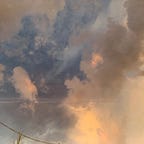In the “Landscape Armatures” lecture, Kristina explained that the visual understanding of the landscape as a texture makes us think of it as a surface, when it’s actually a volume shaped by time and flows. In order to really understand these abstract patterns we need to take a step back and question the deeper processes at play. This immediately made me think of a landscape I saw during a flight in April: the Sandhills in North-Western Nebraska. I’d never seen anything like it before. The land was covered in striations, strips of water and earth layered one after the other. I was so intrigued by the form of the landscape, especially because it wasn’t immediately apparent to me that I was looking at sand.
Watching the lecture and looking at the satellite imagery of the area, I realized these corridors of sand and water were in fact armatures. Zooming out to a wider scale, I began to understand the geological, aeolian, sedimentary, and cultural processes that made this landscape possible. Looking at satellite imagery, it’s clear the Sandhills are in the alluvial plains of rivers with headwaters in the Rocky Mountains. What isn’t visible though, is that the Sandhills sit on top of the deepest portion of the Ogallala Aquifer which spans eight states, from South Dakota to Texas. So, these little pockets of water and wetlands in Northern Nebraska are linked to ranch land 600 miles away in Texas. There are of course many more geological and cultural processes in this region but it was fascinating to me to use this a personal example for understanding the four-dimensional relationship between pattern and process/form and flow.
Thoughts on the readings:
Gary Strang’s article, “Infrastructure as Landscape” (1996), made me wonder whether putting our industrial infrastructure on display would make people rethink their consumption. Do we have a responsibility as designers to reveal infrastructure systems, in a rejection of the problematic norm of “hiding, screening, and cosmetically mitigating infrastructure in order to maintain the image of the untouched natural surroundings of an earlier era” (p. 11)? Would raising awareness to the presence of these systems make us question our dependence on them? I found it interesting to read Michael Hough’s article while still thinking through these questions.
In “Nature as Infrastructure: Strategies for Sustainable Regional Landscapes” (2007), Hough makes the argument that people should be curious about the landscapes they live in, in order to be “better stewards of the land” (p. 56). In a sense, it felt like the strategies and examples Hough was proposing were answering the questions I had after reading Strang’s piece. I found the example of the Emscher Valley in Germany’s Ruhr Valley to be particularly helpful. It made it clear that leaving traces of the past, preserving industrial history, was actually an educational opportunity. Industrial remnants could serve as monuments and the vegetation growing there could be allowed to thrive. It’s as if he was saying to lean into the reality that we live in an industrial era instead of trying to return to some moment of time where the landscape was “natural” and “untouched.” Instead, ecological restoration projects could use what’s already present on site.
